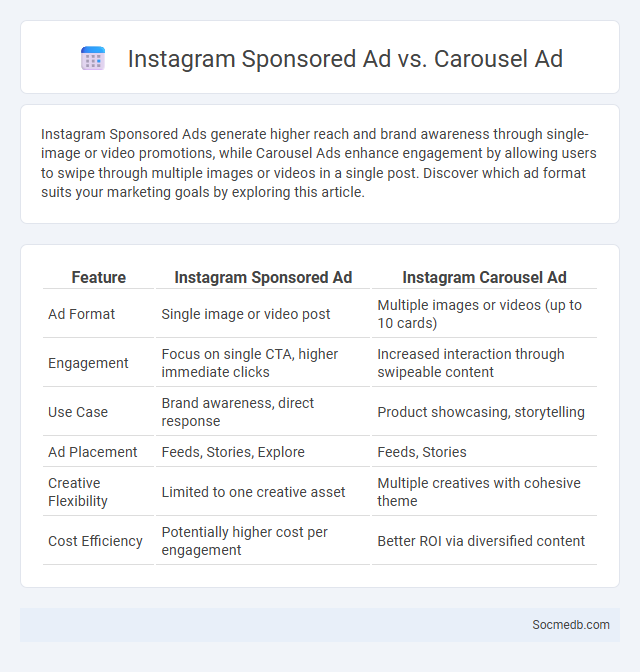
Photo illustration: Instagram Sponsored Ad vs Carousel Ad
Instagram Sponsored Ads generate higher reach and brand awareness through single-image or video promotions, while Carousel Ads enhance engagement by allowing users to swipe through multiple images or videos in a single post. Discover which ad format suits your marketing goals by exploring this article.
Table of Comparison
| Feature | Instagram Sponsored Ad | Instagram Carousel Ad |
|---|---|---|
| Ad Format | Single image or video post | Multiple images or videos (up to 10 cards) |
| Engagement | Focus on single CTA, higher immediate clicks | Increased interaction through swipeable content |
| Use Case | Brand awareness, direct response | Product showcasing, storytelling |
| Ad Placement | Feeds, Stories, Explore | Feeds, Stories |
| Creative Flexibility | Limited to one creative asset | Multiple creatives with cohesive theme |
| Cost Efficiency | Potentially higher cost per engagement | Better ROI via diversified content |
Introduction to Instagram Advertising Formats
Instagram offers multiple advertising formats designed to boost Your brand visibility and engagement. These include photo ads that showcase stunning visuals, video ads that deliver dynamic storytelling, carousel ads allowing multiple images or videos, and Stories ads providing immersive, full-screen experiences. Understanding these formats helps tailor Your marketing strategy for maximum impact and audience reach.
What Is an Instagram Sponsored Ad?
An Instagram sponsored ad is a paid promotional post designed to reach a targeted audience beyond an account's followers, boosting brand visibility and engagement. These ads appear seamlessly within users' feeds, stories, or explore pages, featuring clear calls-to-action like "Shop Now" or "Learn More" to drive user interaction. Leveraging Instagram's advanced targeting options, advertisers can tailor campaigns based on demographics, interests, and behaviors for maximum marketing effectiveness.
Understanding Instagram Carousel Ads
Instagram carousel ads enable businesses to showcase multiple images or videos within a single sponsored post, increasing engagement by offering diverse content. These ads support up to ten cards, each with independent links, ideal for storytelling, product demonstrations, or highlighting features. By leveraging carousel format, marketers can boost click-through rates and optimize ad performance through sequential messaging and interactive visuals.
Key Differences Between Sponsored and Carousel Ads
Sponsored ads on social media are single-image or video promotions designed to reach a broad audience with a clear call to action, often boosting brand awareness or driving traffic. Carousel ads allow you to showcase multiple images or videos within a single ad unit, enabling interactive storytelling and highlighting various products or features. Your choice between these ad formats depends on whether you want to emphasize detailed product narratives or quick, impactful messaging to maximize engagement.
Audience Targeting Capabilities
Social media platforms offer advanced audience targeting capabilities by utilizing user demographics, interests, behaviors, and location data to deliver highly personalized advertisements. These targeting options enable brands to reach specific segments, enhancing engagement rates and return on investment. Machine learning algorithms further refine audience selection by analyzing user interactions to optimize ad performance and conversion outcomes.
Creative Flexibility: Single Image vs. Multi-Image
Creative flexibility in social media advertising hinges on the choice between single image and multi-image formats, where single images provide a focused, impactful message ideal for brand recognition. Multi-image posts, such as carousels, enable storytelling through sequential visuals, increasing engagement and allowing deeper exploration of products or features. Data from platforms like Instagram shows multi-image ads can boost click-through rates by up to 30%, highlighting their effectiveness in campaigns requiring detailed showcase and consumer interaction.
Engagement Rates Comparison
Engagement rates on social media platforms vary significantly, with Instagram averaging around 1.22%, Facebook approximately 0.09%, and Twitter about 0.045%, indicating higher user interaction on visually-driven content. TikTok outperforms many platforms, boasting an engagement rate of 5.3%, largely due to its short-form video content and algorithm favoring user participation. Analyzing these metrics is crucial for marketers aiming to optimize content strategies and maximize audience engagement.
Cost and ROI Analysis
Measuring the cost and ROI of social media marketing involves analyzing expenses such as content creation, ad spend, and platform management against tangible outcomes like lead generation, brand awareness, and sales conversion rates. You can optimize your budget allocation by tracking key performance indicators (KPIs) like cost-per-click (CPC), engagement rates, and customer acquisition cost (CAC), enabling precise adjustments to campaigns. Leveraging analytics tools for social media platforms provides detailed insights into ROI, ensuring your investment drives measurable business growth.
Case Studies: Sponsored vs Carousel Ad Performance
Case studies analyzing sponsored ads versus carousel ads reveal distinct performance metrics across various industries, with carousel ads typically generating higher engagement rates and lower cost-per-click (CPC). For instance, retail brands report a 30% increase in click-through rates (CTR) when using carousel ads featuring multiple product images compared to single-image sponsored ads. Data from Facebook advertising analytics confirm that carousel campaigns often lead to improved conversion rates and enhanced user interaction by allowing dynamic storytelling and showcasing diverse offerings in a single ad unit.
Choosing the Right Ad Format for Your Goals
Selecting the ideal social media ad format depends on clearly defined marketing goals such as brand awareness, lead generation, or direct sales. Video ads excel in capturing attention and driving engagement, while carousel ads are effective for showcasing multiple products or features in a single campaign. Understanding audience behavior and platform-specific strengths, like Instagram's visual appeal or LinkedIn's professional targeting, ensures maximum ROI from your ad spend.
 socmedb.com
socmedb.com